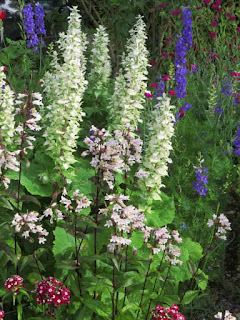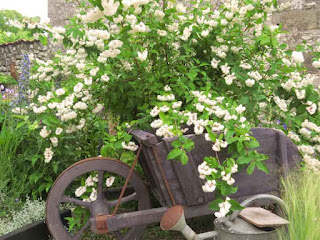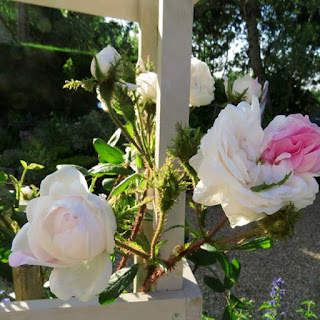"Summer makes a silence after spring"
- Vita Sackville-West
 |
| Serenity reigns... well, sometimes |
Not sure that I totally agree with Vita's comment, given the manic twittering as a flock of goldfinches eyes up the birdbath for a drink, or the repetitive clucking of a black redstart warning the world that our cat is on the prowl. Even insects thrum noisily past your ear as you settle down for a doze in the shade.
 |
| Drenched but not bedraggled - 'Scarborough Fair' |
But finally those chill winds and sudden rainstorms have calmed into welcome breezes which refresh the midday heat and allow butterflies to roam lazily between flowers.
It seems that some roses recover better from rain than others...
'Scarborough Fair' is possibly my favourite climber and her delicate blooms seem to survive a fair bit of punishment without being blemished or losing petals.
She's also planted in semi-shade which is a help on hot days.
It's undeniably pretty but can be a bit leggy so I tried underplanting with a ferny-leaved Galega officinalis var. alba, which has the RHS stamp of approval.
I sowed this last year and we had a few flowers; but it's now more robust as it pushes up between the rose stems, giving the relaxed impression of a natural hedgerow.
I see that Galega is commonly known as 'goat's rue' or 'French lilac', and the flowers do in fact have a hint of lilac when you look at them closely; but I've not come across any wild versions rambling in meadows around here!
Some garden writers are a bit sniffy about galega but it works well in tandem with the rose and I enjoy its airy foliage which freshens up an otherwise shady corner of the courtyard.
Other pale accents are currently provided by this creamy-greeny salvia from Turkestan, which is drought resistant, and Penstemon digitalis 'Husker Red' which is going over now but still looks fine with its dark stems and leaves.
A contrasting background is offered by the annual blue larkspur - always a mainstay in June - and magenta flowered lychnis. We used to have a white version of the latter but this hasn't come back from seed, unlike its brash rival which pops up everywhere.
Our pink and white sweet williams - called 'Homeland' - have been a great success and people have remarked on the fact that they're taller and more striking than the ordinary plain varieties, some of which have got rather lost under the abundant foliage in our borders.
One plant in particular has produced lots of white streaks on its petals as it goes over, so the flowers still appear remarkably fresh after some six weeks in flower.
As they're biennials, I'll leave a few stems for seeding purposes and dig up the rest to make space for my next batch of babies. In this case I've potted up some Dianthus barbatus 'Sooty', which the catalogue promises will be fetchingly dark all over!
'Scarborough Fair' is possibly my favourite climber and her delicate blooms seem to survive a fair bit of punishment without being blemished or losing petals.
She's also planted in semi-shade which is a help on hot days.
 |
| Rosa mutabilis growing with Galega officinalis var. alba |
Light and dark planting
Another rose, which seems to do better in shade, is the fragile Rosa mutabilis growing outside our living room window where we can watch its orange buds opening to pale pink flowers, which quickly become darker with age.It's undeniably pretty but can be a bit leggy so I tried underplanting with a ferny-leaved Galega officinalis var. alba, which has the RHS stamp of approval.
I sowed this last year and we had a few flowers; but it's now more robust as it pushes up between the rose stems, giving the relaxed impression of a natural hedgerow.
I see that Galega is commonly known as 'goat's rue' or 'French lilac', and the flowers do in fact have a hint of lilac when you look at them closely; but I've not come across any wild versions rambling in meadows around here!
Some garden writers are a bit sniffy about galega but it works well in tandem with the rose and I enjoy its airy foliage which freshens up an otherwise shady corner of the courtyard.
 |
| Salvia turkestanica with Penstemon 'Husker Red' and Dianthus barbatus 'Homeland' |
A contrasting background is offered by the annual blue larkspur - always a mainstay in June - and magenta flowered lychnis. We used to have a white version of the latter but this hasn't come back from seed, unlike its brash rival which pops up everywhere.
Our pink and white sweet williams - called 'Homeland' - have been a great success and people have remarked on the fact that they're taller and more striking than the ordinary plain varieties, some of which have got rather lost under the abundant foliage in our borders.
 |
| Dianthus barbatus 'Homeland' - after weeks in flower |
As they're biennials, I'll leave a few stems for seeding purposes and dig up the rest to make space for my next batch of babies. In this case I've potted up some Dianthus barbatus 'Sooty', which the catalogue promises will be fetchingly dark all over!
 |
| Penstemon digitalis 'Husker Red' |
The few penstemons we've found on sale locally have been rather garish and I've noticed that their flower colour doesn't always sit well with a pale green foliage.
I've found 'Husker' to be variable depending on where it's sited in the garden: if there's too much shade, the foliage doesn't darken properly and it can look a bit insipid. You need that sharp contrast of white petals against deep maroon stems for it to be truly effective.
 |
| Catanche caerulea or Cupid's Dart |
The one listed by Chiltern's as a 'Best Seller' sounds very similar but apparently grows taller - to a height of two to three feet - so I may have to try some of their seeds just to find out if there's a difference in the type we have growing locally.
 |
| Bupleurum rotundifolium 'Garibaldi' |
It's difficult to make out the overall shape when grown amongst other plants, hence I've used a plain background to isolate both stems and leaves. Height varies, depending on whether it's grown in sun or shade - anywhere between one and four feet.
I still need to work out the right kind of planting combination to make the most of its attributes, so will probably bring some stems indoors to arrange in a vase together with a few possible companions.
Meditation and observation
 |
| Meditation of the feline kind |
As a child I used to think these were the most boring tasks imaginable: I'd rather be on my bike or climbing up into a tree house - even digging the veg patch held more appeal!
So we get older and turn into our mothers, reaching for trug and trowel rather than carving out a new patch for ourselves.
But that's only possible because the hard work has been done earlier and your garden should be in good shape now; it just remains to enjoy it and keep an eye on everything.
To that end, dead-heading has become a pleasurable routine which I prefer to do in the cool of the morning, when shadows are still soft and low light shines into the depth of your borders, illuminating any little problems which might need sorting sooner rather than later.
 |
| Early morning teasel |
By removing the spent flowers on almost everything - from larkspur to lychnis to roses - you're putting energy into more growth and flowering, keeping the magic going a bit longer.
And by looking closely into your plants, you notice if there are any problems with weeds or pests. Sometimes we take action if growth seems particularly threatened; other times we find that natural predators come to the rescue, or that there's enough food and flowers for everyone... so why worry?



























